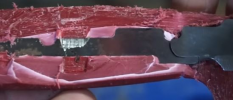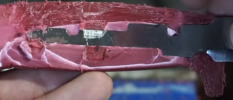-
The BladeForums.com 2024 Traditional Knife is ready to order! See this thread for details: https://www.bladeforums.com/threads/bladeforums-2024-traditional-knife.2003187/
Price is $300 ea (shipped within CONUS). If you live outside the US, I will contact you after your order for extra shipping charges.
Order here: https://www.bladeforums.com/help/2024-traditional/ - Order as many as you like, we have plenty.
You are using an out of date browser. It may not display this or other websites correctly.
You should upgrade or use an alternative browser.
You should upgrade or use an alternative browser.
Mora companion vs Mora 511
- Thread starter Chapp
- Start date
- Joined
- Dec 7, 2019
- Messages
- 3,481
If I were to pick one up, I’d probably lean towards the 511. More of an aesthetic choice rather than function really. I’m already quite happy with my Kansbol, Eldris, and Bushcraft black haha. Heck, I kinda want a 511 Robust now.
Going by conventional wisdom, the Companion is the more camping-oriented of the two while the 511 is the more utility-oriented. Former is marketed towards outdoor guys while the latter is more for construction or crafting guys. The Companion has that nice rounded handle for bushcrafty activities while the 511 has that finger guard for extra safety. To be completely honest though, there’s plenty of overlap here that you can get away with using either knife for any reasonable cutting task.
Heck, get ‘em both lol.
Going by conventional wisdom, the Companion is the more camping-oriented of the two while the 511 is the more utility-oriented. Former is marketed towards outdoor guys while the latter is more for construction or crafting guys. The Companion has that nice rounded handle for bushcrafty activities while the 511 has that finger guard for extra safety. To be completely honest though, there’s plenty of overlap here that you can get away with using either knife for any reasonable cutting task.
Heck, get ‘em both lol.
- Joined
- Jul 3, 2019
- Messages
- 14,628
I'd go for the companion, personally- I've got no experience with the 511, but I really do think they nailed ergonomics on the companion.
There's also a certain amount of bragging about the Companion's tang being a 3/4 tang that I don't hear about the 511, which leads me to believe that's a feature the 511 doesn't have.
I would guess that the practical differences between the knives are next to nothing, so follow your heart.
There's also a certain amount of bragging about the Companion's tang being a 3/4 tang that I don't hear about the 511, which leads me to believe that's a feature the 511 doesn't have.
I would guess that the practical differences between the knives are next to nothing, so follow your heart.
- Joined
- Jan 6, 2016
- Messages
- 1,012
- Joined
- Jul 3, 2019
- Messages
- 14,628
For the record, you'd be correct that the notches in a tang adds points of higher stress, but we're not talking about a free-standing steel piece.I don't care for the big notches in some of the more recent knives, as it adds stress points. No problem if you're not batoning.
The tang is supported by the injection molded handle.
If a Mora was to fail during batoning, I would be surprised to see it fail inside the integrated handle.
- Joined
- Dec 5, 2018
- Messages
- 1,437
I think a lot of weight will go into whether you prefer 3.6" blade (511) or 4.1" (Companion). The handle of the 511 is more neutral, but the Companion's handle isn't that far off from neutral.
I think the notches are to adjust the balance of the knife and add some mechanical "grip" to ensure the handle can't slip off. I also question whether you'd be able to tell if the the end of the tang cracked inside the molded handle, rather than closer to the blade.511 tang:
View attachment 1779661
Companion HD tang:
View attachment 1779664
Keep in mind they have changed tang styles over the years, presumably for ease in automated manufacturing. I don't care for the big notches in some of the more recent knives, as it adds stress points. No problem if you're not batoning.
- Joined
- Jul 3, 2019
- Messages
- 14,628
100% they're there for tang-handle connection. I doubt Mora is fine-tuning the center of gravity of the knife by fractions of an ounce, particularly when blade length plays such a large role in that.I think the notches are to adjust the balance of the knife and add some mechanical "grip" to ensure the handle can't slip off.
per my earlier post, I don't think a mora would ever break inside the handle. The steel tang is supported by the plastic.I also question whether you'd be able to tell if the the end of the tang cracked inside the molded handle, rather than closer to the blade.
Edited to add: here's a guy who broke a Mora, and it failed at the blade.
Last edited:
- Joined
- Dec 5, 2018
- Messages
- 1,437
The design of the 511 tang looks more convoluted than necessary for just mechanical connection purposes, but it's speculation either way.100% they're there for tang-handle connection. I doubt Mora is fine-tuning the center of gravity of the knife by fractions of an ounce, particularly when blade length plays such a large role in that.
per my earlier post, I don't think a mora would ever break inside the handle. The steel tang is supported by the plastic.
I agree that the failure would most likely be on the unsupported part of the blade. My point was that, even if you did manage to break the tang inside the handle, how would you know?
- Joined
- Oct 11, 2013
- Messages
- 21,618
To be perfectly candid, we're talking about one of the best deals for the money in the knife world. You can order them right both right now for under $25 (minus whatever shipping would be from whoever of the Bladeforums supporting dealers you go with!) combined.
I'd buy 'em both and test them out, worst case, you throw the loser in a glovebox, or camping bag.
I'd buy 'em both and test them out, worst case, you throw the loser in a glovebox, or camping bag.
Wild Willie
Gold Member
- Joined
- Mar 19, 2018
- Messages
- 4,368
I've had both, like both. I found the finger guard on the 511 unnecessary, so I cut it down a bit. Like said above, if it fits the budget, buy both and give them a shot. Either way you win.
- Joined
- Jun 5, 2019
- Messages
- 758
I prefer the companions handle shape and slightly longer blade personally. But I find both knives to be a fantastic deal for the price!
- Joined
- Jan 6, 2016
- Messages
- 1,012
The red one did fail, though I don't know what kind of abuse it took. Interesting break line.For the record, you'd be correct that the notches in a tang adds points of higher stress, but we're not talking about a free-standing steel piece.
The tang is supported by the injection molded handle.
If a Mora was to fail during batoning, I would be surprised to see it fail inside the integrated handle.

- Joined
- Jul 3, 2019
- Messages
- 14,628
Interesting break for sure- I'm guessing the crack initiated at the top side, as that's where the stress would concentrate and ended at the bottom.The red one did fail, though I don't know what kind of abuse it took. Interesting break line.
View attachment 1779859
From the looks of it I'm guessing it was a torsional force that was being applied when that tang broke.
Was it broken during the removal of the handle? it looks like someone cut through the top side of the handle, then pounded a screwdriver in, marring the metal, and then twisted it to snap of the rest of the handle.
That twisting motion could have easily broken that tang like that.
Henry Beige
Gold Member
- Joined
- Jun 1, 2015
- Messages
- 3,715
Companion for comfort, 511 for price. I think the Bahco Carpenter’s knife comes in a little cheaper than the 511, while approaching the Companion for comfort. As pointed out above, the best handle is shared by Kansbøl/2000/Garberg/Eldris.
Somehow, I have an abiding fondness for the 510 Allround, which used to be the least expensive Mora, and is still the most basic.
Somehow, I have an abiding fondness for the 510 Allround, which used to be the least expensive Mora, and is still the most basic.
My take in Mora's lineup is that unless you choose two totally opossite knives (say a Companion VS Eldris, or jump from a laminated to stainless to carbon blade)... they all pretty much perform the same, as they share the scandi grind. I guess it comes to personal prefference about the handle.
Choose whichever you feel more comfortable with.
Mikel
Choose whichever you feel more comfortable with.
Mikel
- Joined
- Jul 23, 2021
- Messages
- 1,248
I'd take the Companion over the 511, because it gives you a bit more blade, but for the price you might as well get both. For just a little more you can get the Heavy Duty Companion, which is as much or more knife than most people will actually ever need.
- Joined
- Jul 3, 2019
- Messages
- 14,628
Just figured I'd follow up- I wrote this email to the folks over at Mora:The design of the 511 tang looks more convoluted than necessary for just mechanical connection purposes, but it's speculation either way.
Hello,
First, a sincere thank you for your great product- I wish you the greatest continued success.
Second, a question has come up on a knife forum, for which there was much speculation, but I was hoping you could answer definitively.
What is the purpose of the notches in the tang of the injection molded knives, such as the 511 basic or the Companion?
Thank you for your time,
Mora took the time to respond, which I think is pretty great for a company pumping out sub 100 dollar knives:
Hi Daniel,
The notches on the tang are intended for indexing (position) and fixation in different tools and blade carriers in the production. They also help to fix the blade in the handle after moulding.
Vänliga hälsningar / Best regards,
Thomas Eriksson
Product Specialist Morakniv®
- Joined
- Jul 3, 2019
- Messages
- 14,628
Also, USMCPOP, any follow up on this? I really want to know more about this break.
The red one did fail, though I don't know what kind of abuse it took. Interesting break line.
View attachment 1779859
Interesting break for sure- I'm guessing the crack initiated at the top side, as that's where the stress would concentrate and ended at the bottom.
From the looks of it I'm guessing it was a torsional force that was being applied when that tang broke.
Was it broken during the removal of the handle? it looks like someone cut through the top side of the handle, then pounded a screwdriver in, marring the metal, and then twisted it to snap of the rest of the handle.
That twisting motion could have easily broken that tang like that.


